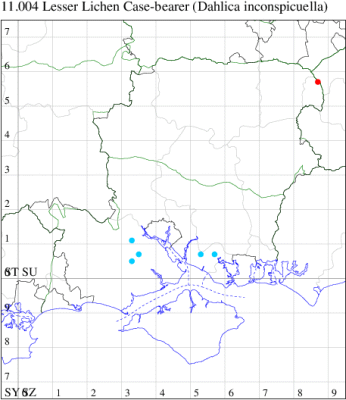2021 Annual Report for: Psychidae / Naryciinae
For species seen in 2021 that had less than or equal to 100 records, full details are included; for more common species, the earliest, latest and highest count by vice-county are shown. The narrative for each species is taken from the main Hantsmoths website, and it is possible that some information on abundance and occurrence can get out of date, as it is impossible to keep up with all changes; however it should give a good introduction to each species. The tables in each species account summarise the previous status, and that for the current year.
For the maps, all records prior to 2021 are shown by a blue dot (the larger the dot, the more recent), with the current year's records shown in red. As previous records are superimposed on any report for 2021, new sites have greater emphasis (i.e. will show as 'more red').
In the species accounts, an asterisk next to a location indicates a new 10km square record; earliest ever dates are highlighted in orange, and latest ever in red. Initials in the species accounts refer to the recorders listed here. Please get in touch if you identify any omissions or errors, in particular if you have records that have yet to be submitted. Details of how to submit records can be found here.
11.004 [B&F: 0177] Lesser Lichen Case-bearer Dahlica inconspicuella (Stainton, 1849) - pRDB3
Nationally scarce (Na) where lichens and moss are common in southern England, with records north to Yorkshire. In Hampshire known from only a handful of sites in the south of the county, at Denny Wood, Bramshaw Woods and in and around Fareham, where apparently widespread. Not recorded from the Isle of Wight to date. Wingspan male 9-13 mm, female wingless. The adult moths are seen occasionally, but most records are of larval cases. Larva feeds on lichens growing on rocks, tree trunks, fence posts and old walls, living within a movable case.
Records prior to 2021
| Vice County | #Records | #Individuals | First Record | Last Record |
|---|---|---|---|---|
| 11 | 5 | 3 | 1974 | 2007 |
2021 records
| Vice County | #Records | #Individuals | Max Quantity |
|---|

Records by year
Records by week (adult)
Records by week (larval)
Record Details
VC12: #N/A